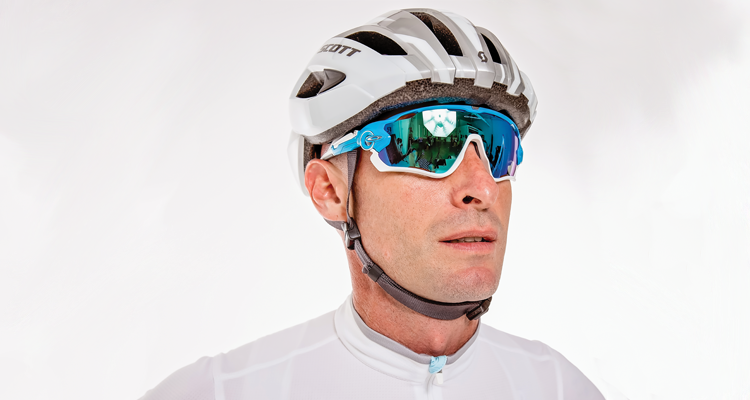Inever wanted to think about how well my helmet would fare in a real life crash situation. Frankly, I didn’t like the idea that a crash would involve my head. Statistical probability. If you ride enough miles you will crash. Ride enough years of enough miles and it will happen eventually. In March, the law of averages caught up to me. (Check out, Helmet Head: Surviving a Road Bike Crash, for all the details.)
The first new cycling helmet I tried out is the top of the line offering from Scott Sports USA, The Arx Plus. The “Plus” indicates this model has the MIPS Brain Protection System. MIPS is a low friction layer between your head and the helmet and the Arx Plus was one of the first race helmets to include this technology (In July several other manufacturers announced they would start to make a MIPS optional helmet). The low friction layer allows your head a few additional millimeters of movement inside the helmet at the moment of impact to minimize the impact. The concept is based on the same layers of protection you have naturally inside your head.
Why doesn’t every helmet have this? The technology is new and there is still some debate about the additional protection it provides.
The nice thing about adding MIPS to a helmet is that it does not change the structural integrity of it.
It does add additional costs but the weight penalty is a mere 20 grams. I feel the cost and the weight is a big part of the reluctance from other manufacturers to put the technology into their top of the line race helmets. Many cyclists looking for top of the line equipment spend too much time focused on a few grams here or there. Total weight of the Scott Helmet was claimed at 260 Grams.
The Scott Arx plus cycling helmet is a conservatively style available in either White/Grey or Black/Red. The retention system is very good and uses a larger adjustment dial on the back of the fit system. I found on the fly adjustments really easy to do with either hand. It’s probably 40 grams heavier than some of its competition but I felt the weight was not a detriment. The Micro Rotary Adjustment System II is a solid retention system and that leads to the comfort being so high. (Looking for a place to ride? Everyone Rides, Everyone Gives a Little!)
The padding is ample (again, very comfortable) however as I am bald (by choice of course) I am more likely to have sweat coming down my forehead and into my face. If you have hair or you’re not a really sweaty person this may not be an issue for you. For me, I need better sweat retention setup. I’ve used 3 or 4 different styles of sunglasses and the helmet has played nicely with all of them including some of the largest pairs I own. The shape of the vents makes it tough to store sunglasses upfront. I typically put mine into the back of the helmet so it wasn’t a big deal.
Airflow through the helmet is really good but I wouldn’t call it great. I did take this helmet on a 6 hour, 130 mile ride in the middle of July and I never gave it a second thought after putting it on. It isn’t the most aerodynamic and it doesn’t have the best airflow. It doesn’t have the best sweat retention I’ve ever used. I have 5 helmets and the Scott Arx Plus is my first choice the majority of the time. It isn’t the best at any of the features above but it does everything really well. Super comfortable, easy to use and plays nice with all of my sunglasses (including the huge new Oakley Jawbreakers). The biggest advantage to this helmet is the price. Most of it’s competition is $75-125.00 more than the $149.00 Scott Arx Plus. That price makes this helmet the least expensive lid in my garage and knowing it has the added security of the MIPS technology, it makes this helmet a no brainer.
Looking for other great new products? Read on…
6 Health Apps Fitness Bloggers Swear By
Cryotheraphy: Freezing Yourself For Better Health
New Sports Medicine Technologies Promise to Fix You Fast


